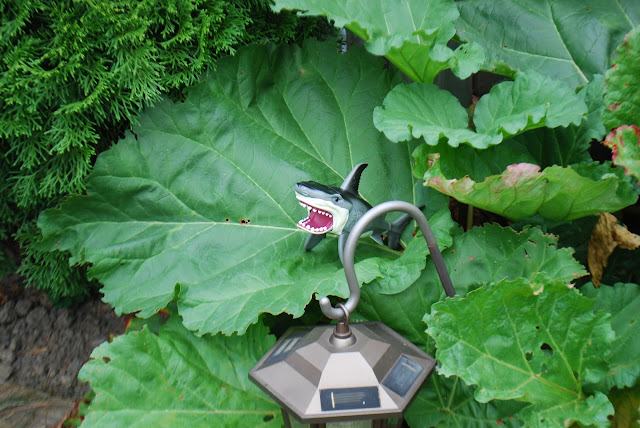Cet article en français.
Este artículo en español.
 |
| Doo-dum. ... Doo-dum. Doo-dum-doo-dum-doo-dum-DOO-DUM! Squee ! The shark, hidden in the rhubarb patch. |
Hélène :
A few days ago, my son's boredom grew to the point where it was time to invent a new game fast (as a matter of fact, the simple use of the word "new" is enough to shake him out of his bad moods). A variation on the Hide-and-seek game, but with hints. Only, we don't hide in turns. Instead, we hide toys, as you can see on the photos.
While my son was counting out loud, I went hiding this plastic shark (Go on and do admit that you too want one for bathtime), first over a rhubarb leaf, which is strong enough to support its weight. Coming back to my son, who was done with its counting task, I gave him a clue : "The shark is hiden in the rhubarb!" And he was gone, knowing very well where it was (but there is the appeal : certain plants named during the course of our game where unknown to him). Our game was working double duty : we were having a great time while he was learning the name of different new plants.
 |
| In the carrots! |
While my son was counting out loud, I went hiding this plastic shark (Go on and do admit that you too want one for bathtime), first over a rhubarb leaf, which is strong enough to support its weight. Coming back to my son, who was done with its counting task, I gave him a clue : "The shark is hiden in the rhubarb!" And he was gone, knowing very well where it was (but there is the appeal : certain plants named during the course of our game where unknown to him). Our game was working double duty : we were having a great time while he was learning the name of different new plants.
 |
| Perched over a giant, drooping sunflower head. |
The cleverest part in this, is that it's easy to adapt this game's level of difficulty to each kid's skills and knowledge. For instance, my son is 4 and a half years old at the time of publishing this article, and he can count up to thirty at least, both in French and English, so a parent could work with that, teaching is child to learn about counting numbers. By the way, the world of plants is a marvelous domain to explore while learning another language... (Maybe I'll try Latin with him, one day!) On the other end, he has a little difficulty understanding and following the rules from any game, and as you can deduct from the photos, he needs a relatively big object that's too well hidden in order to succeed. So you can play on many aspects to graduate the game's level of difficulty. For example, an eight year old child will probably have more pleasure looking for an object the size of a marble that will be well hidden from view.
But what's marvelous is that a garden is full of creative hiding spots. Not only bushes, but a whole and rich vegetal world. It could be a sunflower head or a nook between two branches of a tree. These days, when we're not in the middle of a heat wave or a rainstorm, this game comes back often, at my son's request, and it not only gives him the opportunity to play outside, but also to learn !
 |
| Jaws between grape vines and Stevia, holding a Cosmos blossom between its teeth. |






